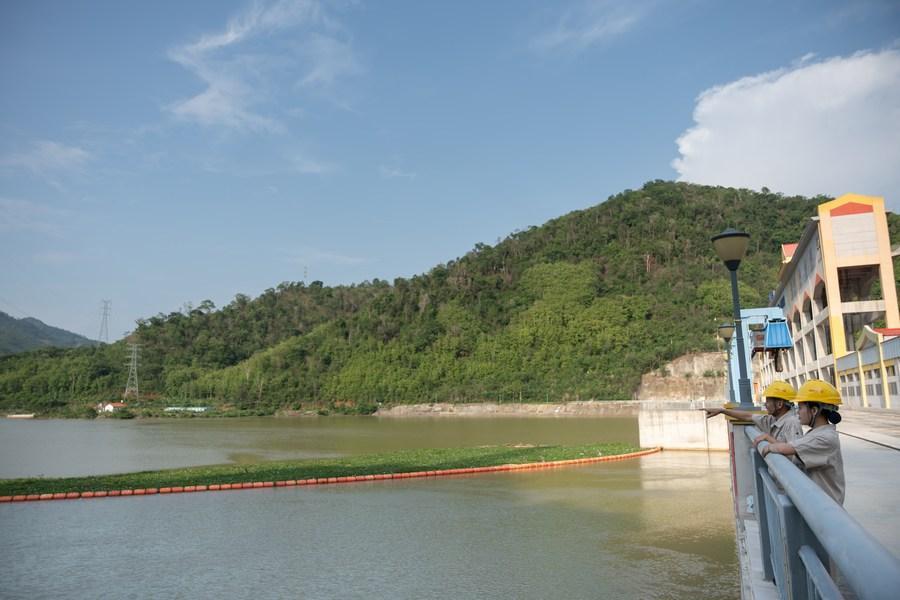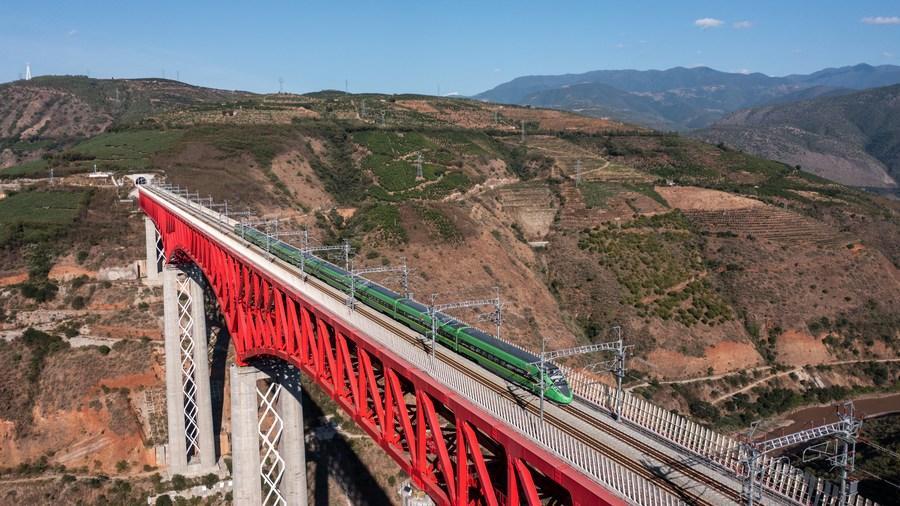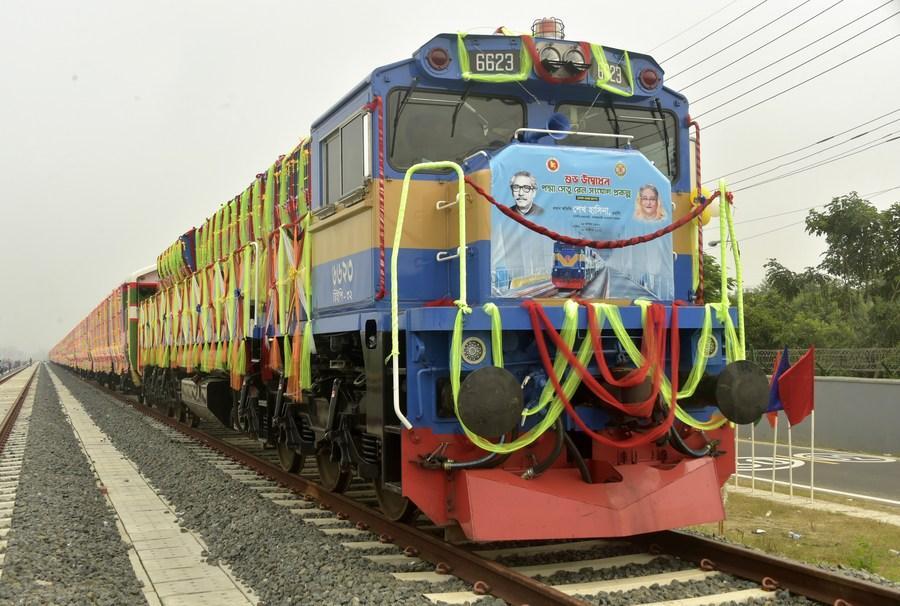


Xinhua | December 28, 2023

Nouphet Thongsakda (L) and Phavady Nalathone talk on the dam of the Nam Ou 1 hydropower plant invested by the Power Construction Corporation of China (PowerChina) in Luang Prabang, Laos, on June 16, 2023. (Photo by Kaikeo Saiyasane/Xinhua)
On the 10th year of the Belt and Road Initiative (BRI), the cooperation platform has become a popular international public good and added new growth drivers to the global economy at a time when the world is facing tremendous changes.
By building up railways, highways, power plants and dams, it helps local people in the Asia-Pacific region lead a better life. By enhancing cooperation and people-to-people exchanges, it popularizes the vision of a global community of a shared future.
Drawing the blueprint for the next decade in a recently released document titled "Vision and Actions for High-Quality Belt and Road Cooperation: Brighter Prospects for the Next Decade," China is committed to encouraging all parties to strive toward equal cooperation and mutual benefit, propelling Belt and Road cooperation into a new phase characterized by high-quality development.

This aerial photo taken on Nov. 23, 2022 shows a Fuxing bullet train running on the Yuanjiang bridge of the China-Laos Railway in southwest China's Yunnan Province. (Xinhua/Hu Chao)
FRUITFUL ACHIEVEMENTS
Data show that from 2013 to October 2023, total imports and exports between China and BRI participating countries surpassed 21 trillion U.S. dollars, and China's direct investment in BRI partner countries topped 270 billion dollars.
Being a miniature of the robust and unimpeded trade shown by the figure, the 1,035-km China-Laos Railway, which began operations in December 2021, has generated more benefits since it launched cross-border passenger service on the railway in April this year.
Linking the Lao capital Vientiane with Kunming, the capital of southwest China's Yunnan Province, the railway has quickly become the preferred option for a growing number of international travelers.
"The BRI has played a critical role in building connectivity within the ASEAN (the Association of Southeast Asian Nations) and between China and ASEAN," said Thong Mengdavid, a research supervisor at the Asian Vision Institute, a Phnom Penh-based independent think tank.

This photo taken on Oct. 10, 2023 shows a decorated train at the Chinese-built Padma Bridge Rail Link Project (PBRLP) in Munshiganj, Bangladesh. (Xinhua)
In Bangladesh, the first train of the Padma Bridge Rail Link Project departed from a new station on the outskirts of the capital Dhaka on Oct. 10, marking a dream come true "to cross the Padma river by train," the country's Prime Minister Sheikh Hasina said.
The entire 172-km project, which will eventually lead to Jashore in the southwestern region of Bangladesh, is scheduled for completion in 2024.
It will serve as a vital channel that connects Dhaka and more than 20 districts in the southern area of Bangladesh and will also be an important part of the trans-Asian railway network to promote regional connectivity and economic development of Bangladesh.
In Cambodia, the Chinese-invested Siem Reap Angkor International Airport in northwest Cambodia's Siem Reap province was officially inaugurated on Nov. 16, carrying the hope to link Cambodia to the world, according to Prime Minister Hun Manet, and will give a big boost to the tourism sector in Siem Reap with the local residents directly benefitting from it.
GLOBAL WELLBEING
"The Belt and Road cooperation has created more jobs and provided more vocational training and education opportunities for the people in partner countries, and thus improved their livelihoods in the process of development," said Anna Malindog-Uy, vice president of the Manila-based think tank Asian Century Philippines Strategic Studies Institute.

A comprehensive inspection train (R) enters the platform of Halim Station while a high-speed electrical multiple unit (EMU) train (L) stops on the platform in Jakarta, Indonesia, Dec. 25, 2023. (Xinhua/Xu Qin)
For Khairul Ikmal, a villager in Malangnengah, Purwakarta Regency of Indonesia, the Jakarta-Bandung High-speed Railway (HSR) under the BRI cooperation changed his life as an assembly line worker in a shoe factory. He was recruited in 2019 and learned to become a welder after five months of training.
In service for two months, the 142-km railway has handled over 1 million passenger trips, brought smoother and more efficient journeys, and provided many other villagers with employment as well as incomes. Ikmal fulfilled his long-held dream of owning a motorcycle thanks to his new job.
"Since the railway project is completed now, I plan to run a welding studio and use the technology I have learned over the past four years to make products such as guardrails and window guards," he said.
According to statistics provided by Kereta Cepat Indonesia China, a joint venture consortium between Indonesian and Chinese firms that constructs and runs the HSR, 45,000 Indonesian employees were trained on-site during the railway's construction. As the first overseas high-speed railway project that fully uses Chinese railway systems, technology, and industrial components, the project has created about 51,000 jobs in Indonesia.
Landmark projects like these in the region also covered a wide range of areas beyond transport. In the past decade, BRI cooperation featured green and high-quality development and has brought socio-economic benefits to regional countries, improving the lives of local people and infrastructure and offering opportunities for further growth in the green sector, experts believed.

Engineers hoist the last rotor of the Suki Kinari Hydropower project in the Mansehra district of Khyber Pakhtunkhwa province, Pakistan, on June 10, 2023. (China Gezhouba Group Corporation/Handout via Xinhua)
Abid Qaiyum Suleri, executive director of the Sustainable Development Policy Institute, an Islamabad-based think tank, said China has not only helped Pakistan overcome the severe energy crisis but also assisted in promoting green development.
In northwest Pakistan, the construction of the Suki Kinari Hydropower project has been making significant progress. With a total installed capacity of 884 megawatts, it is expected to generate some 3.21 billion kilowatt-hours of clean electricity annually, replacing 1.28 million tons of coal and reducing 2.52 million tons of carbon dioxide emissions per year.
